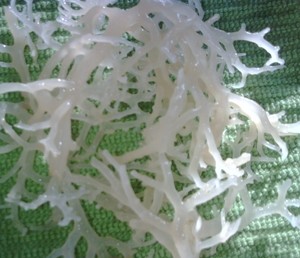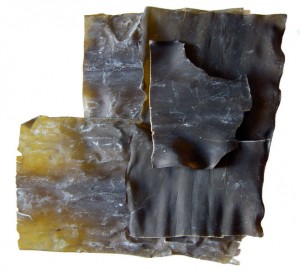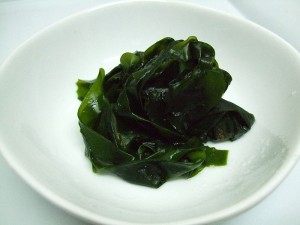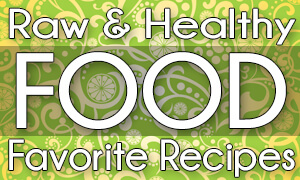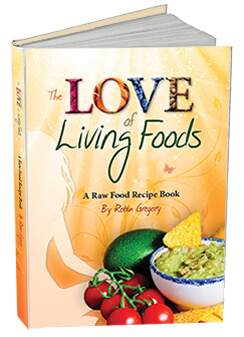Sea vegetables
2012
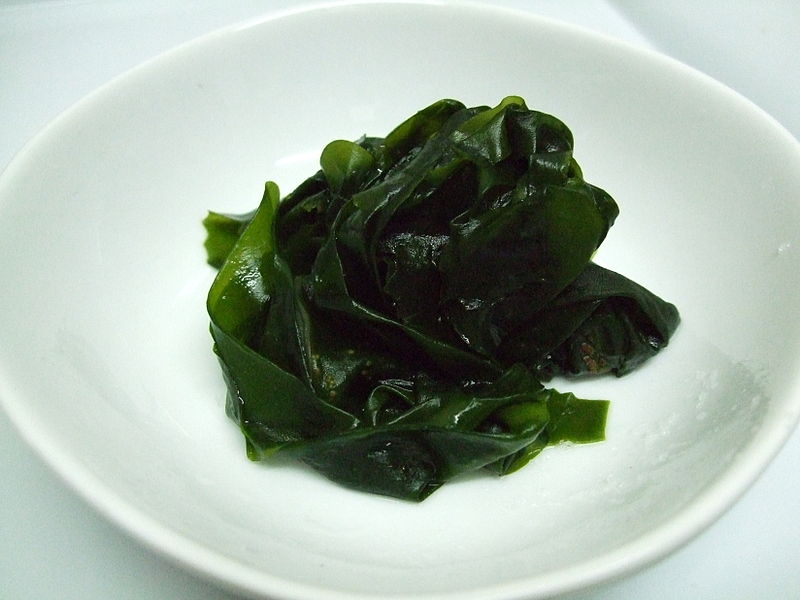
Sea vegetables offer one of the broadest ranges of minerals of any food, containing virtually all the minerals found in the ocean and a variety of unique phytonutrients. They do not appear to depend on carotenoids and flavonoids for their antioxidant benefits, but have several other types, including alkaloid antioxidants.
About – Sea vegetables are neither plants nor animals but classified in a group known as algae. There are thousands of types of sea vegetables and each is unique, having a distinct shape, taste and texture. They grow both in the oceans salt waters as well as in fresh water lakes and seas. They often grow on coral reefs and can grow at deep depths, but only where the sunlight can reach down as they need sunlight to grow. There is evidence to show that Japanese cultures have been consuming sea vegetables for more than 10,000 years and Japan remains one of the world’s largest producer and exporter of sea vegetables. The names we use to call sea vegetables are often Japanese names: arame, hijiki, dulse, kombu, nori, and wakame
Nutrition – Sea vegetables are low calorie and low fat, but extremely high in nutrients, which are mostly bioavailable. In vitamins they are especially high in B vitamins, especially folate and vitamins C, E and K. Sea vegetables are singled out nutritionally for their high and unique mineral content, in which you can find: iron, calcium, zinc, iodine, copper, magnesium, manganese, molybdenum, phosphorus, potassium, selenium, vanadium, and more. Also, for some, such as iodine, you cannot find a more concentrated source. Vanadium, found in sea vegetables, helps to increase our cells sensitivity to insulin and helps balance blood sugar levels, lowering our risk of type 2 diabetes. The iron found in sea vegetables is accompanied by vitamin C, which acts to increase the bioavailability of iron. Sea vegetables have powerful antioxidant properties and have been shown to help lower total cholesterol and LDL cholesterol and to improve cardiovascular health. They are also a good source of lignans which help fight cancer. They also contain fiber, EFA’s and protein. For instance, nori contains as much protein as soybeans and it is an easily digestible source.
.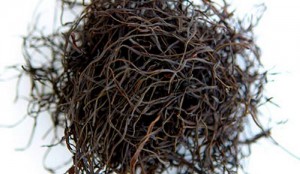
Arame is a sweet mild tasting lacy, wiry shaped brown sea vegetable used in Asian cuisines. Arame is a member of the kelp family and is harvested from the cold waters off the coast of South Korea and Japan. It grows in wide leaves up to one foot in length which are sliced into long thin strands.
Arame contains few calories is and virtually fat-free, yet is rich in nutrients and has many health benefits. It is abundant in betacarotene (pro vitaminA), thiamine (B1), riboflavin (B2), niacin (B3), pantothenic acid (B5), B6, folate (B9) and vitamin C. It is rich in minerals such as calcium, sodium, magnesium, potassium, iodine, iron and zinc. Its high levels of iodine are crucial for overall thyroid health. The thyroid, a part of the endocrine system, is responsible for regulating metabolism and an underactive thyroid can result in weight gain, depression and fatigue. Arame is a potent immune system booster and is full of antioxidants and phytochemicals, which help rid the body of free radicals. Arame also contains alginic acid, which according to studies helps bind and draw toxins, such as lead, cadmium and mercury from the body.
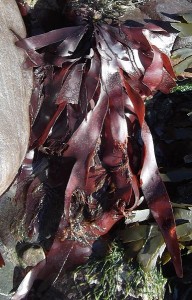
Dulse is a reddish brown sea vegetable, which grows on the northern coasts of the Atlantic and Pacific oceans. It has a soft, chewy texture and is considered a delicacy by many. The earliest record of it is 1400 years ago when St Columba and the monks of Iona ate it.
Dulse is exceptionally nutritious, containing up to 20% protein and has an abundance of vitamins and minerals, including beta carotene, which the body uses to manufacture vitamin A, and also vitamins B6, B12, C and E. It has high levels of minerals, including: magnesium, iron, calcium, potassium and fluoride as well as being a natural source of iodine, essential for thyroid hormone secretion and thyroid gland health. Dulse is rich with trace minerals from the sea, is a good source of fiber and is surprisingly low in sodium compared to other seaweeds.
Irish Moss is a species of red algae which grows abundantly on the Atlantic Ocean coast. It has almost no flavor and is used for its gelatinous quality as a thickening agent in recipes, mainly desserts. It is the vegetarian answer to gelatin. Irish moss is mainly mucilaginous, with the polysaccharide carragenan comprising 55% of its made up, which gives it its gelling factor. It also has 10% protein, containing most notably taurine, a sulphur based amino acid mostly excluded from plant sources and therefore the vegetarian diet, and comprises an abundance of minerals, 15% total. It is especially high in iodine and sulphur and an excellent source of bromine, calcium, iron, magnesium, manganese, phosphorous, potassium, selenium and zinc. It is also high in beta carotene and pectin. It has many medicinal uses and has been used to treat ulcers, arteriosclerosis, cancer, radiation poisoning, obesity, bladder complaints cholesterol build up, and is well documented to have an anticoagulant effect on the blood. It is also used to increase the metabolic rate, to diminish varicose veins and to give strength to hair, skin, nails and all connective tissues.
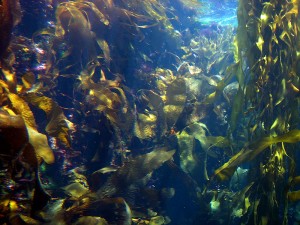
Kelp is a large seaweed belonging to the brown algae Phaeophyceae, of which there are an estimated 30 different varieties. Kelp grows in underwater forests in shallow clear oceans that are cooler than 68 degrees F. It is famous for its ability to spread, kelp grows 20 inches a day and can reach 200 feet long. Kelp is light brown to dark green in color. It is usually eaten raw and often sold dried, in flakes or as a powder.
Kelp is high in B complex vitamins, which among their many functions are well renowned for their ability to combat stress and increase energy levels. Kelp has over 70 minerals, highest in potassium, magnesium, iron, calcium, and especially iodine. The iodine in kelp is a great help with thyroid conditions. Kelp is plentiful in its healthful nutrients and contains an abundance of enzymes, growth hormones and trace elements. Kelp is known to kill the herpes virus and suppress AIDS. It boosts the immune system and helps to alleviate arthritic pain. Kelp improves the function of the liver and aids in problems with poor digestion, including constipation and bowel gas. It benefits the mucous membranes in the body and lowers cholesterol helping to fight heart disease and has lots of antioxidants helping to fight cancer as well. Kelp increases body energy, stimulates the metabolism and helps to control body weight. Kelp is highly rated by naturopaths and nutritional therapists for its high levels of nutrients and beneficial uses.
Kombu is a very dark kelp generally sold in strips or sheets and often used as a flavoring for soups. It is similar to wakame in appearance, taste and nutritionally, but is not as popular as wakame. It contains glutamic acid, a natural flavor enhancer, which encouraged researchers to develop a synthetic form, resulting in monosodium glutamate (MSG).
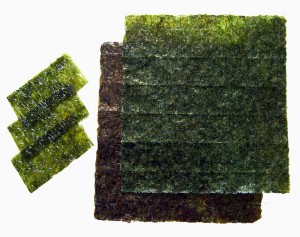
Nori is what is used in most sushi and is an important part of Japanese, Chinese and Korean cuisines. Nori grows like a sea lettuce but we usually find it pressed into sheets. Nori is a dark purple-black color that turns phosphorescent green when toasted. The roasted dark green sheets are more commonly found in supermarkets and the dried black nori is richer nutritionally, but can be harder to find. Nori is sometimes called laver, and is made by a shredding and rack-drying process that resembles papermaking. Japanese nori is grown in the Ise Bay region – a mountainous and well-forested coastal area where the sea waters are still relatively pure. Development is restricted in order to protect the seaweed quality and purity. The farming of Porphyra plants (nori) takes place in the sea where they are attached to nets and suspended at sea level, where farmers have their boats. The plants grow rapidly, requiring about 45 days from seeding until the first harvest. Multiple harvests can be taken from a single seeding, typically at about ten-day intervals. Mechanical harvesters are largely used for harvesting and as of recently, processing of the raw product is largely mechanized, for efficiency and consistency, duplicating traditional manual processing steps.
Nori is low-fat, high in protein and a good source of vitamins A, B2 (riboflavin) and C. It is rich in potassium, magnesium, iodine and iron.
Wakame is a type of kelp. It is a dark green highly nutritious fern-like sea vegetable that grows on the ocean floor and is mainly grown and harvested in Japan. It is a staple part of the Japanese diet and most commonly used in salads and to make miso soup. Wakame is usually sold dried and must be soaked before using.
Wakame has a high level and vast array of nutrients and especially of minerals. Wakame contains a variety of vitamins including vitamins A, C, E, and K, as well as folate and riboflavin. Its mineral profile is highest in magnesium, iron, calcium, and iodine. Wakame is extremely low in calories with only about five calories per serving. It has minimal fat but what it does have are vital essential fatty acids. Wakame is also a source of lignans which are thought to play a role in preventing certain types of cancer, particularly breast cancer. It also contains alginic acid which bonds with heavy metals to remove them from the body. Wakame seaweed has been shown to have the potential to promote weight loss, lower blood pressure, and even reduce the risk of breast cancer.
